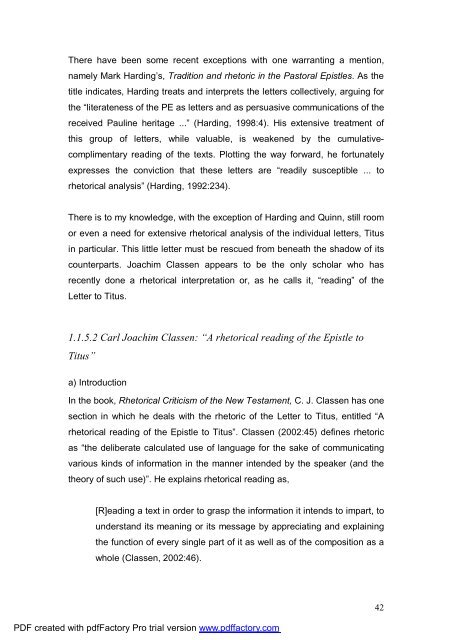A Text centred rhetorical analysis of Paul's Letter to Titus
A Text centred rhetorical analysis of Paul's Letter to Titus
A Text centred rhetorical analysis of Paul's Letter to Titus
You also want an ePaper? Increase the reach of your titles
YUMPU automatically turns print PDFs into web optimized ePapers that Google loves.
There have been some recent exceptions with one warranting a mention,<br />
namely Mark Harding’s, Tradition and rhe<strong>to</strong>ric in the Pas<strong>to</strong>ral Epistles. As the<br />
title indicates, Harding treats and interprets the letters collectively, arguing for<br />
the “literateness <strong>of</strong> the PE as letters and as persuasive communications <strong>of</strong> the<br />
received Pauline heritage ...” (Harding, 1998:4). His extensive treatment <strong>of</strong><br />
this group <strong>of</strong> letters, while valuable, is weakened by the cumulative-<br />
complimentary reading <strong>of</strong> the texts. Plotting the way forward, he fortunately<br />
expresses the conviction that these letters are “readily susceptible ... <strong>to</strong><br />
<strong>rhe<strong>to</strong>rical</strong> <strong>analysis</strong>” (Harding, 1992:234).<br />
There is <strong>to</strong> my knowledge, with the exception <strong>of</strong> Harding and Quinn, still room<br />
or even a need for extensive <strong>rhe<strong>to</strong>rical</strong> <strong>analysis</strong> <strong>of</strong> the individual letters, <strong>Titus</strong><br />
in particular. This little letter must be rescued from beneath the shadow <strong>of</strong> its<br />
counterparts. Joachim Classen appears <strong>to</strong> be the only scholar who has<br />
recently done a <strong>rhe<strong>to</strong>rical</strong> interpretation or, as he calls it, “reading” <strong>of</strong> the<br />
<strong>Letter</strong> <strong>to</strong> <strong>Titus</strong>.<br />
1.1.5.2 Carl Joachim Classen: “A <strong>rhe<strong>to</strong>rical</strong> reading <strong>of</strong> the Epistle <strong>to</strong><br />
<strong>Titus</strong>”<br />
a) Introduction<br />
In the book, Rhe<strong>to</strong>rical Criticism <strong>of</strong> the New Testament, C. J. Classen has one<br />
section in which he deals with the rhe<strong>to</strong>ric <strong>of</strong> the <strong>Letter</strong> <strong>to</strong> <strong>Titus</strong>, entitled “A<br />
<strong>rhe<strong>to</strong>rical</strong> reading <strong>of</strong> the Epistle <strong>to</strong> <strong>Titus</strong>”. Classen (2002:45) defines rhe<strong>to</strong>ric<br />
as “the deliberate calculated use <strong>of</strong> language for the sake <strong>of</strong> communicating<br />
various kinds <strong>of</strong> information in the manner intended by the speaker (and the<br />
theory <strong>of</strong> such use)”. He explains <strong>rhe<strong>to</strong>rical</strong> reading as,<br />
[R]eading a text in order <strong>to</strong> grasp the information it intends <strong>to</strong> impart, <strong>to</strong><br />
understand its meaning or its message by appreciating and explaining<br />
the function <strong>of</strong> every single part <strong>of</strong> it as well as <strong>of</strong> the composition as a<br />
whole (Classen, 2002:46).<br />
PDF created with pdfFac<strong>to</strong>ry Pro trial version www.pdffac<strong>to</strong>ry.com<br />
42

















